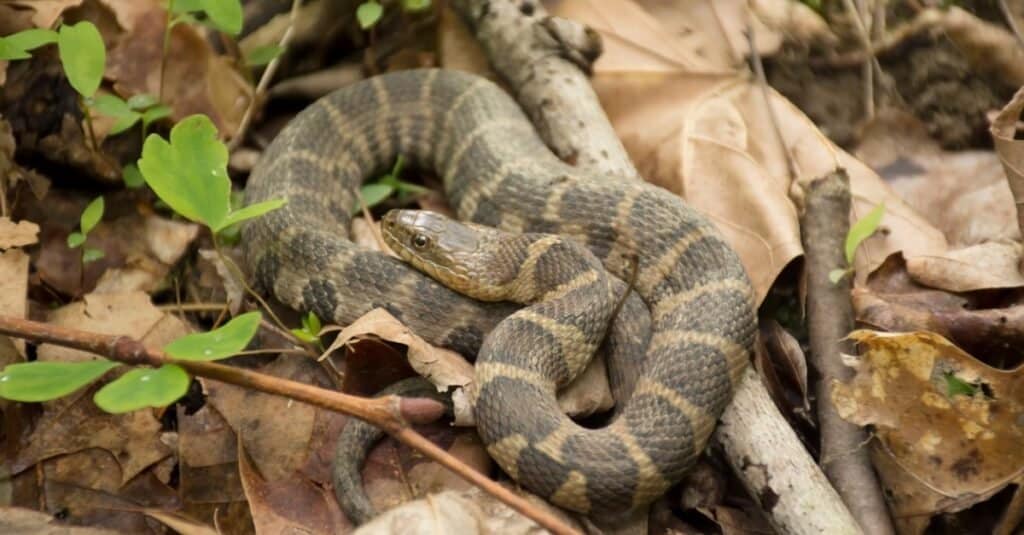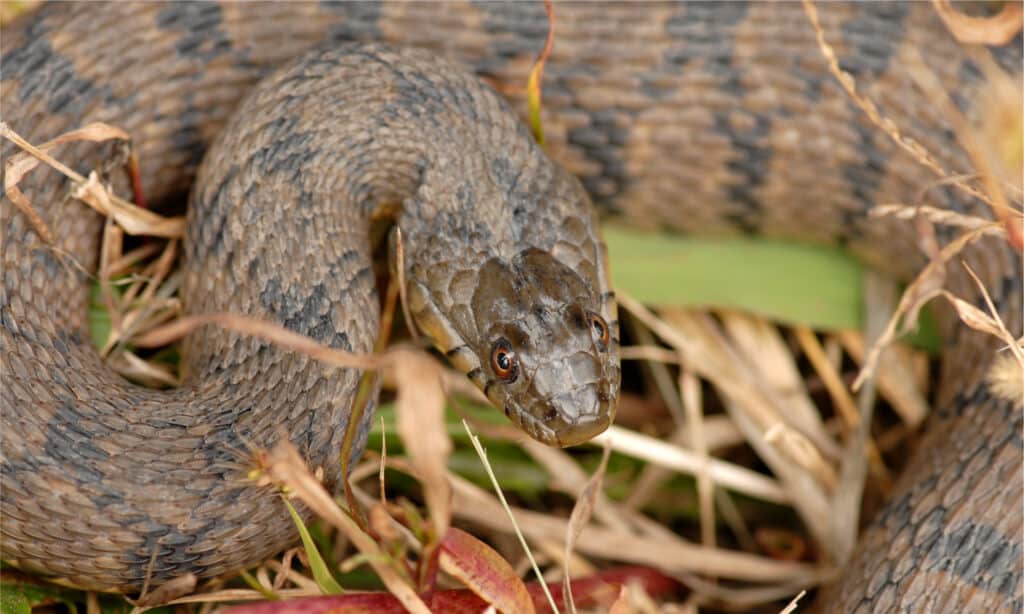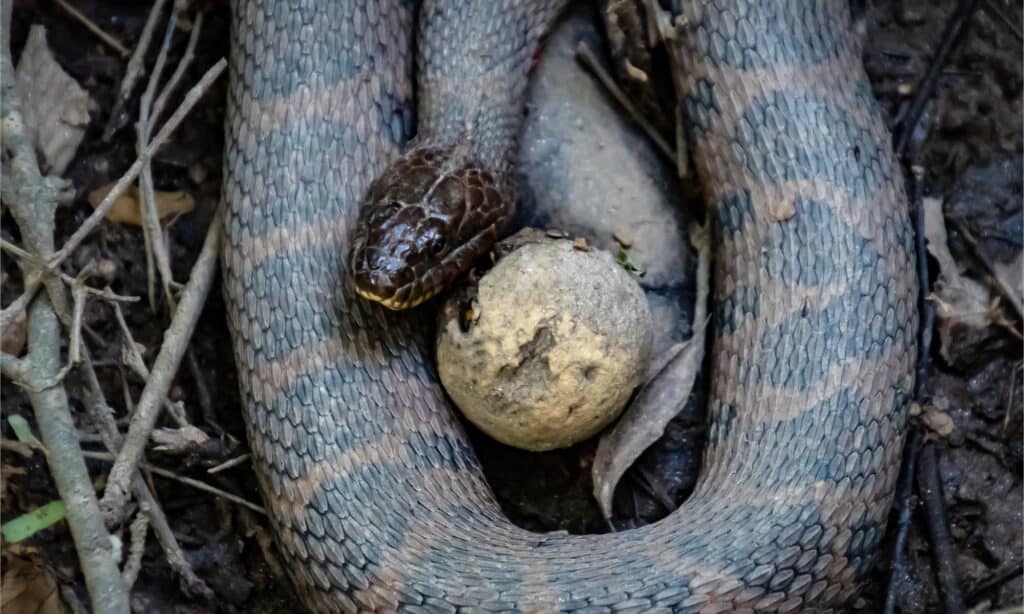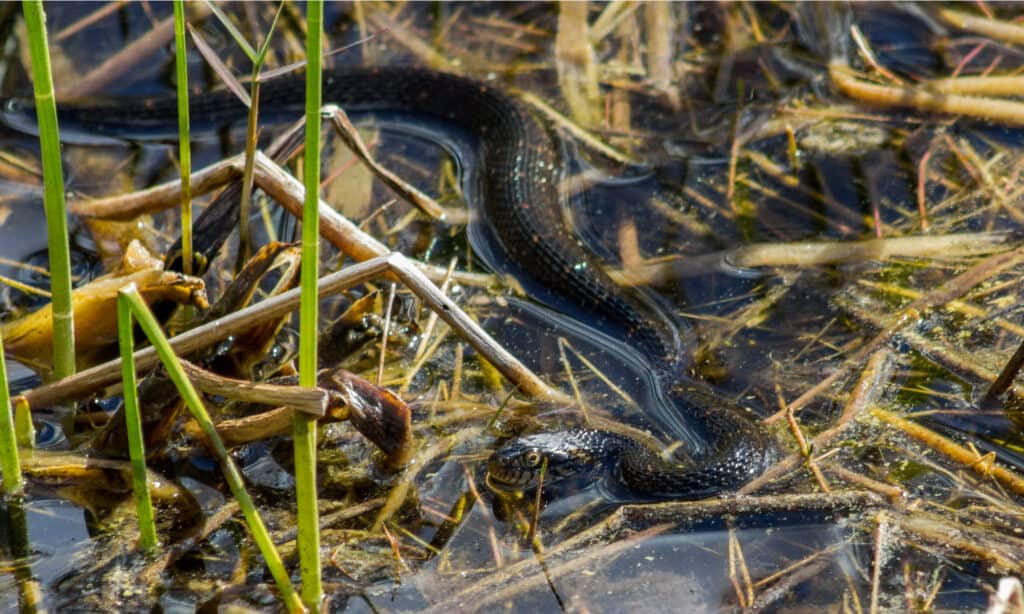The Volunteer State is home to a wide range of reptiles, with around 32 total species of snakes residing in the area. But what sorts of snakes should you be aware of if you’re planning on venturing into Tennessee’s waters? Fortunately, water snakes– as in members of the Nerodia genus– are non-venomous, but there are still plenty of reasons why you should be aware of them and be able to identify them whether you live in the state or plan on visiting. Let’s take a closer look at the main five species of water snakes in Tennessee below.
1. Northern Water Snake (Nerodia sipedon)

The northern water snake is a common snake in Tennessee and is harmless to humans.
©iStock.com/IcemanJ
The northern water snake, taxonomically known as Nerodia sipedon, is a unique snake for its close resemblance to the venomous cottonmouth. Like the cottonmouth, this species has a mostly grayish-brown body marked by dark brown bands or stripes. Unlike the cottonmouth, however, the species is entirely non-venomous and generally non-aggressive towards humans. It ranges from around 24 to 40 inches long and has a bulky, muscular body.
Out of Tennessee’s five main types of water snakes, the northern water snake is the most common and widespread. Notably, two different subspecies of the northern water snake exist; the midland and common variants. At a glance, the two are very similar in appearance and mainly differ in their geographic range. While the common subspecies mainly live in the northeastern reaches of Tennessee, you can find the midland subspecies in the state’s western half.
2. Plain-Bellied Water Snake (Nerodia erythrogaster)

The next water snake you might stumble upon in Tennessee’s waters is the plain-bellied water snake. Its scientific name, erythrogaster, refers to its often reddish-colored belly, though it can vary in color from beige to light brown and even auburn. In contrast, the upper half of its body is typically a uniform, dark brown, albeit sometimes with a similarly reddish sheen. On average, it reaches around 30 to 48 inches long when fully grown.
Two main subspecies of the plain-bellied water snake reside in the Volunteer State: the yellow-bellied and copper-bellied varieties. As you might imagine, the copper-bellied variety tends to have a reddish belly as its scientific name suggests. Both types are quite rare in the state, though. Furthermore, they are often unnecessarily killed by humans who mistakenly identify them as cottonmouths.
Like other water snakes in the Nerodia genus, both varieties are non-venomous and generally non-aggressive towards humans. They prefer to feed on small fish and amphibians. They’re most often found in still or slow-moving bodies of water like swamps, ponds, and wetlands.
3. Northern Diamond-Backed Water Snake (Nerodia rhombifer)

A diamondback water snake in Tennessee can punch a painful bite, but it is non-venomous.
©Rusty Dodson/Shutterstock.com
A subspecies of the diamond-backed water snake, the northern variety lives throughout western Tennessee. In particular, it mainly resides along the Tennessee, Mississippi, and Cumberland River drainages in the area. Large populations also exist in northwestern Tennessee’s Reelfoot Lake.
This unique species’ large, heavy body ranges from 30 to 48 inches in length when fully grown. The upper half of its body is dark brown with small light brown, beige, and yellowish diamond-shaped markings. Its belly, meanwhile, is usually a pale yellow color, accented by tiny crescent-shaped black markings.
Although this species is, like all the others on this list, non-venomous, it does have an unfortunately painful bite! This is because of its especially sharp teeth, which are perfect for gripping and biting into the slippery, oily fish it prefers to feed on. It also is often unfortunately mistaken for the cottonmouth. This is due to its defensive display in which it raises and flattens its body to make itself appear larger and more threatening.
4. Broad-Banded Water Snake (Nerodia fasciata)

Banded southern water snake can do damage to you if it bites you, despite that it isn’t actually venomous.
©Deborah Ferrin/Shutterstock.com
Also known as the southern water snake, the broad-banded water snake primarily lives in western Tennessee counties bordering the Mississippi River. Like the aforementioned northern diamond-backed water snake, it also has especially large populations in Reelfoot Lake. When they aren’t searching for fish or other aquatic animals to feed upon, you may be able to spot them basking on logs next to slow-moving bodies of water like lakes and swamps.
True to its common name, the broad-banded water snake has a dark brown to grayish-brown body marked by wide, light brown bands or stripes. When fully grown, it ranges from around 24 to 40 inches in length. Its underside is typically a pale yellowish or cream color. It can be easily identified by its distinctive brown stripe along each side of its face.
Just because this species isn’t venomous, though, you still shouldn’t try to pick it up or handle it if you spot it in the wild. Its main defense mechanism is its foul-smelling musk, which it emits from its anal glands. It won’t hesitate to spray you or other predators with this musk if you get too close! Its bite can also be quite painful despite lacking venom due to the snake’s tendency to slash into its victims’ flesh sideways to do more damage.
5. Green Water Snake (Nerodia cyclopion)

The green water snake is a rare Tennessee water snake because its habitat is slowly disappearing.
©EdwinWilke/Shutterstock.com
The green water snake is also known as the Mississippi green water snake. This is because of its native range, which is mainly limited to the areas surrounding the Mississippi River along Tennessee’s western border.
As its name implies, this species has a primarily dark olive green body flecked with small, darker brown markings along the top or dorsal half of its body and pale yellow markings along the sides of its belly. It ranges from around 30 to 55 inches long, making it Tennessee’s largest water snake overall.
Sadly, the green water snake is also one of the Volunteer State’s least common snakes. This is because its primary habitat, the cypress swamp, has been slowly disappearing over time. Currently, the Tennessee Department of Environment and Conservation classifies the species as “extremely rare” and “critically imperiled.” If you’re lucky enough to spot one in the wild, you may see it resting in tree branches overlooking the water.
The photo featured at the top of this post is © Jason Patrick Ross/Shutterstock.com
Discover the "Monster" Snake 5X Bigger than an Anaconda
Every day A-Z Animals sends out some of the most incredible facts in the world from our free newsletter. Want to discover the 10 most beautiful snakes in the world, a "snake island" where you're never more than 3 feet from danger, or a "monster" snake 5X larger than an anaconda? Then sign up right now and you'll start receiving our daily newsletter absolutely free.
Thank you for reading! Have some feedback for us? Contact the AZ Animals editorial team.







